One lesser-known collection at the American Antiquarian Society is a group of broadsides printed on textiles. Broadsides are ephemeral, single-sheet items that are usually printed only on one side. Some topics typical of broadsides include advertisements, official proclamations, theater announcements, and opinions. AAS has approximately 148 textile broadsides that showcase the breadth and type of these objects. The textiles were produced on the same presses that were used for paper printing, and like their paper counterparts, they combined text and decorative elements. These objects were used as keepsakes, souvenirs, or commemorative objects, and some, in theory, could be used as handkerchiefs. The themes include commemorating specific events or people, “persuasive texts” that showcase social or political movements of the time, and instructional textiles that would have been used for teaching tools in reading, spelling, and arithmetic. The commemorative textiles were usually printed on silk, whereas the “persuasive” and instructional textiles were printed on cotton or muslin (Affleck, 2001).
These textiles were created using various transfer methods common in paper printing, including plate printing, letterpress, and lithography. In addition to the content being copied from other printed sources, the decorative elements like the images and borders were also not created specifically for the textile broadside. The same decorative elements are seen in other printed formats like title pages, tail pieces, and on book covers. The tools used to create these decorations were generally made at local type founders, and many of the ornamental borders can be found in catalogues or type specimen books for these foundries (Affleck, 2001).
To best preserve these unique items at AAS, Chief Conservator Babette Gehnrich and I conducted a survey of all our textile broadsides. This survey included assessment of each textile’s condition as well as treatment recommendations. During the survey, I took a thumbnail photograph and assigned priorities and approximate treatment times to each item. Detail of the compiled data can be seen below (Fig. 1).
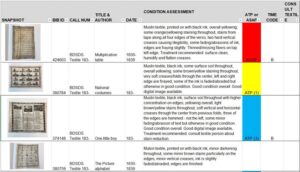
After all the textiles were examined, each of them was rehoused in a Polyester film pocket with an unbuffered piece of paper to help create friction so that they did not move and become wrinkled when pulled from the stacks and handled by researchers in the Reading Room (Fig. 2).
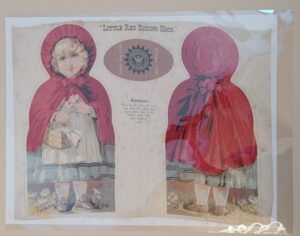
In addition to the single–sided broadsides, there were several printed textiles in the format of a newspaper, either because they were actual newspapers, or they copied a format of newspaper to announce an event. The actual newspaper printed on a textile seen below was called a “blizzard paper” because the paper used for newspaper printing could not reach the Dakotas due to a large blizzard. Thus, they printed on what they had: textiles (Fig. 3). Because these textiles were printed on both sides, they were simply unfolded and placed in polyester film pockets without the paper backing. This “blizzard paper” also demonstrates some common staining seen in the textiles that will hopefully be reduced when more comprehensive treatments are performed.
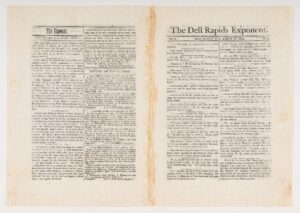
Severely stained or wrinkled textiles were flagged for treatment so researchers will be able to view the text more easily once the stains are reduced or the wrinkles are gently flattened. Additionally, as part of the project, the front and back of each textile was imaged by the Society’s photographer, so that researchers have access to digital surrogates.
Once the survey was completed, Gehnrich reached out to a local textile conservator, Camille Breeze, from Museum Textile Services in Andover, MA. We set up a virtual consultation in our Learning Lab where we were able to utilize our document camera and discuss the different treatment options for all the objects we felt needed to be treated immediately. The curator and assistant curator of Graphic Arts (Lauren Hewes and Christine Morris, respectively) were also able to join in the consultation which allowed for a better understanding of context for the textiles as well as ascertaining which ones were higher priority due to their scarcity (Fig. 4).
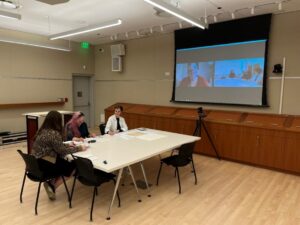
Paper and textile conservation treatments are often very similar in nature, but we wanted to make sure that we fully understood the risks, benefits, and potential problems that could arise during treatment of these textiles. Camille was able to give us some helpful tips and overall guidance for our treatments. Luckily, because the condition issues are all similar, we were able to come up with a streamlined process for most treatments. However, because I will be on leave, we decided to postpone the more comprehensive treatments for when I return. In the Spring of 2024, I was able to complete a couple of minor treatments, including the removal of paper hinges from the verso as well as local flattening to reduce creases, which made the textiles more legible (Figs. 5 and 6).

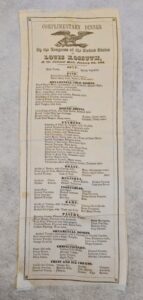
In the Fall of 2024, treatments are anticipated to begin on the remaining textiles. I will create a new blog post about the final steps of this project, so stay tuned!
If you are looking for information on our printed textile collection, check out another blog post written by Lauren Hewes on our ribbon collection:
Marissa Maynard is the Library and Archives Conservator at AAS. Marissa helps to ensure that collections are not only preserved but also usable by researchers, working closely with library staff to prioritize and assess conservation needs.
References
Consulted Lynne Bassett, independent textile and costume historian, elected AAS member (2010).
Affleck, Diane L. Fagan. “Textile Commemoratives and Broadsides from New England’s Mid-Nineteenth Century.” In Textiles in New England II: Four Centuries of Material Life. Boston University, 2001
Celebration and Remembrance: Commemorative Textiles in America 1790-1990. Museum of American Textile History, 199
